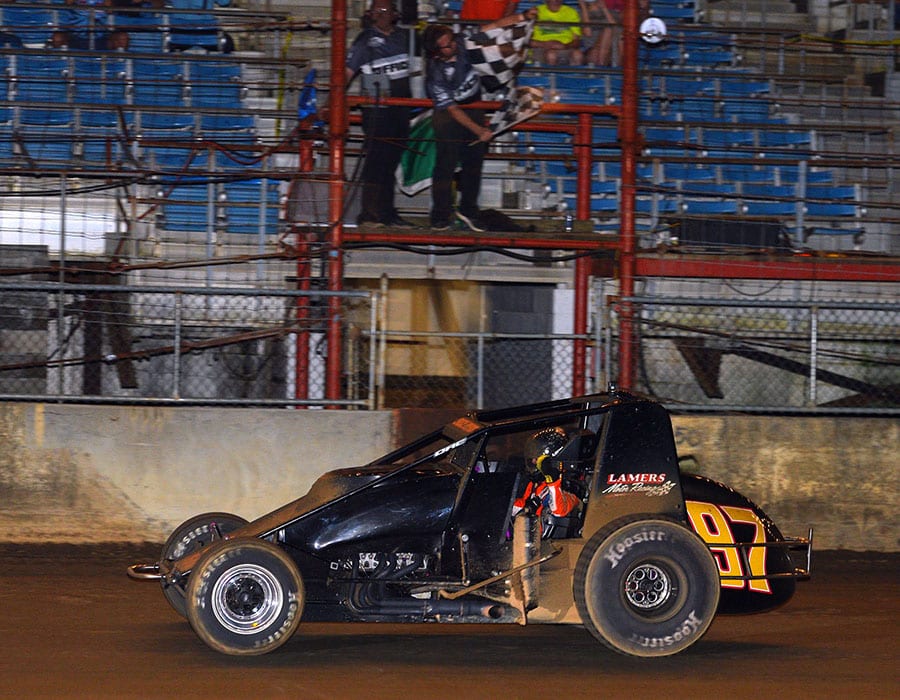Their premier event was the Gold and Glory Sweepstakes held at the fairgrounds from 1924 to 1936. The event drew thousands, paid handsomely and made a star of the “Negro Speed King,” Charlie Wiggins.
Despite all the racing activity, the AAA would only occasionally sanction Championship Trail races at the Indiana State Fairgrounds. But in 1953, Championship racing and the dirt mile consummated a relationship that excelled beyond all expectation.
On Sept. 26, 1953, the track hosted the first Hoosier Hundred. The spectacular finish saw the top four finishers separated only by a scant few feet. Bob Sweikert scored the victory with Manny Ayulo, Johnnie Parsons and Don Freeland so close they could’ve reached out and touched one another.
From that striking beginning, the Hoosier Hundred ascended to iconic status. It became the most important dirt-track race in America and was among the most sought after wins on the Championship Trail.

At one time, the Hoosier Hundred paid more than any Championship race other than the Indianapolis 500 and was behind only Indy and the Daytona 500 in purse size in all of American racing.
The Hoosier Hundred was the realm of giants. Among the winners were Jimmy Bryan, who won three consecutive races, six-time winner A.J. Foyt, four-time consecutive victor Al Unser, Mario Andretti, Parnelli Jones, Pancho Carter, Jack Hewitt, Dave Darland and more recently Kody Swanson, who won the race four years in a row starting in 2015.
That led Courtney to profess after winning this year’s classic, “My name is now alongside many greats. Kody Swanson, one of the best Silver Crown drivers in our lifetime. Foyt, Andretti, Pancho Carter, all those names. It’s incredible.”
Hewitt ranks becoming a three-time Hoosier Hundred winner among his most significant accomplishments.
“To win that race is magic,” said Hewitt. “The previous winners were guys like Bryan, Foyt, Unser, Andretti. To have your name associated with those guys … well, it’s extra special.”
Carter, the 1977 Hoosier Hundred winner, agrees and insists the difficulty of the track adds to the prestige.
“It’s one of the biggest races any driver could win,” explained Carter. “Its claim to fame is the list of previous winners. To be linked with them is amazing. But it’s also a challenging track. It’s different than Springfield or DuQuoin. It’s very hard to do good there. You have to manage the tires, lapped traffic is difficult and the track is constantly changing. You don’t just go out there and run, you have to work at it. And I like that.”
“Winning the Hoosier is so significant for me,” Swanson said, “because it’s my opportunity to be connected to the racing greats that cemented the history of our sport. To stand in front of that covered grandstand with my team after winning is supremely fulfilling. To win it the first time was unbelievable. Winning it four times is indescribable.”
Such a prestigious race on a fabled track produced many singular moments. During the 1970 race, boisterous cheers drowned the engine noise when journeyman Ralph Liguori charged around A.J. Foyt on the last lap to take second place and nearly caught winner Al Unser.
In 1974, unheralded Jackie Howerton tamed the intricacies of turbocharger lag on a dirt track to claim the win in Pat Patrick’s Offy-powered car against the dynamic Viceroy team of Al Unser and Mario Andretti. Prior to that race, Unser or Andretti had led every lap on the dirt miles that season.
In 1967, Andretti and often- bitter rival Foyt fought a ferocious battle for 100 miles, with Andretti squeaking out the victory. Foyt claimed afterward that his brake pedal broke. He’d indeed flung the offending piece at his pits when he roared by. But it caused Andretti to remark, “Why did he need brakes? I never touched mine.”
The unprecedented success of the Hoosier Hundred prompted other motorsports promotions at the Indiana State Fairgrounds. USAC staged memorable stock car races. The State Fair Centuries and the Indiana Classics attracted Indy car and NASCAR stars alike.
Flat-track motorcycle racing pulled in sizeable, enthusiastic crowds. From the first AMA event in 1954 won by Joe Leonard, who would also run the Hoosier Hundred, flat track racing’s best took on the famous oval. Jay Springsteen, Scott Parker, Gene Romero, Gary Nixon, Bubba Shobert, Kenny Roberts and Nicky Hayden battled handlebar to handlebar in excess of 100 mph on the famous clay.
Now that the last engine is silenced, all that remains are the memories of all those momentous times.
The hallowed Indiana State Fairgrounds dirt, the site of some of racing’s most celebrated competition, is now buried under ground limestone and has reverted back to its intended purpose of 150 years ago — horse racing. n
